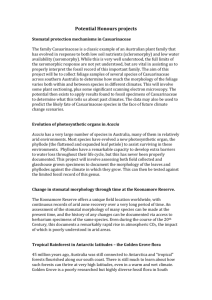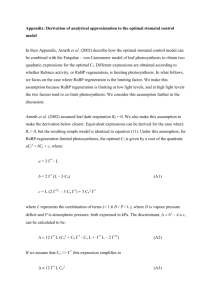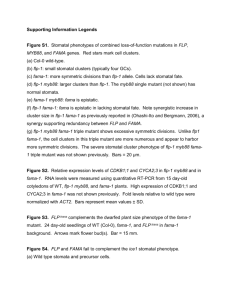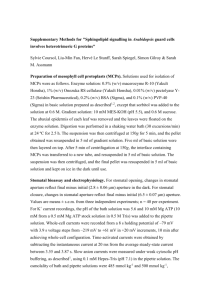COPB 2012 Facette Smith accepted ms w figs
advertisement
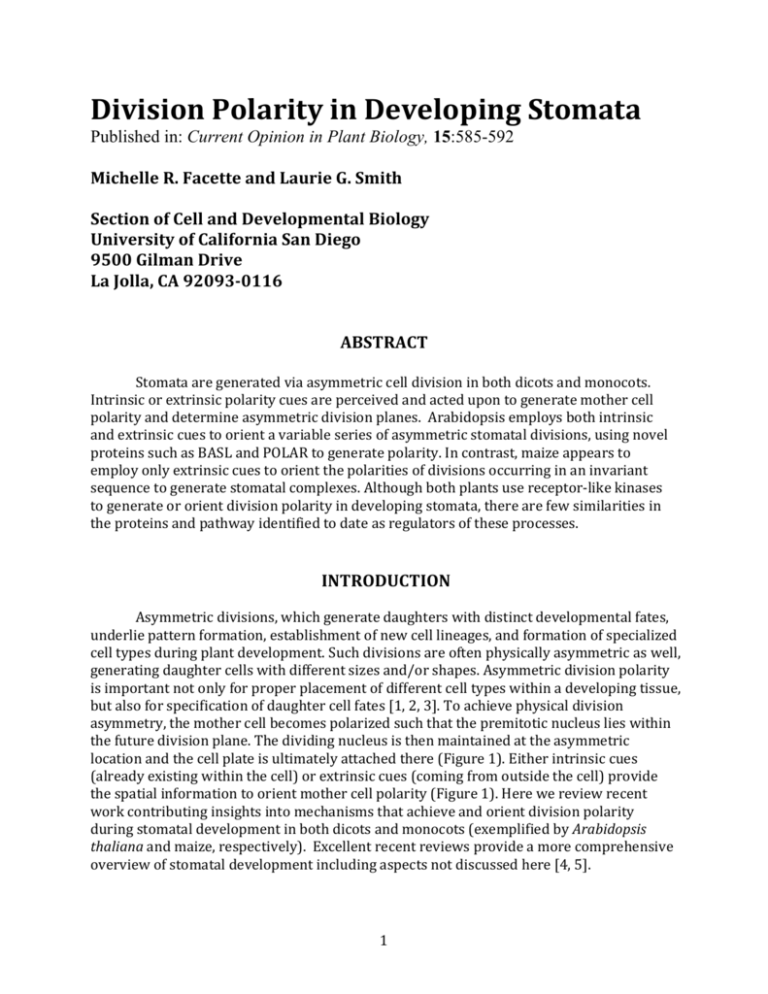
Division Polarity in Developing Stomata Published in: Current Opinion in Plant Biology, 15:585-592 Michelle R. Facette and Laurie G. Smith Section of Cell and Developmental Biology University of California San Diego 9500 Gilman Drive La Jolla, CA 92093-­‐0116 ABSTRACT Stomata are generated via asymmetric cell division in both dicots and monocots. Intrinsic or extrinsic polarity cues are perceived and acted upon to generate mother cell polarity and determine asymmetric division planes. Arabidopsis employs both intrinsic and extrinsic cues to orient a variable series of asymmetric stomatal divisions, using novel proteins such as BASL and POLAR to generate polarity. In contrast, maize appears to employ only extrinsic cues to orient the polarities of divisions occurring in an invariant sequence to generate stomatal complexes. Although both plants use receptor-­‐like kinases to generate or orient division polarity in developing stomata, there are few similarities in the proteins and pathway identified to date as regulators of these processes. INTRODUCTION Asymmetric divisions, which generate daughters with distinct developmental fates, underlie pattern formation, establishment of new cell lineages, and formation of specialized cell types during plant development. Such divisions are often physically asymmetric as well, generating daughter cells with different sizes and/or shapes. Asymmetric division polarity is important not only for proper placement of different cell types within a developing tissue, but also for specification of daughter cell fates [1, 2, 3]. To achieve physical division asymmetry, the mother cell becomes polarized such that the premitotic nucleus lies within the future division plane. The dividing nucleus is then maintained at the asymmetric location and the cell plate is ultimately attached there (Figure 1). Either intrinsic cues (already existing within the cell) or extrinsic cues (coming from outside the cell) provide the spatial information to orient mother cell polarity (Figure 1). Here we review recent work contributing insights into mechanisms that achieve and orient division polarity during stomatal development in both dicots and monocots (exemplified by Arabidopsis thaliana and maize, respectively). Excellent recent reviews provide a more comprehensive overview of stomatal development including aspects not discussed here [4, 5]. 1 DICOTS: VARIABLE DIVISION SEQUENCES Stomata in dicots are produced via asymmetric divisions in which the smaller daughter is a stomatal precursor cell called a meristemoid (Figure 2A; [6]). A meristemoid can differentiate directly into a guard mother cell (GMC), which divides symmetrically to form a guard cell pair [6]. Alternatively, it can undergo additional asymmetric divisions (each producing a meristemoid and a non-­‐stomatal cell) prior to differentiation of the meristemoid as a GMC (Figure 2A; [6]). The orientations of these asymmetric divisions are crucial for the separation of each stomate from its nearest neighbor by at least one non-­‐ stomatal cell (the “one cell spacing rule”), which is important for stomatal aperture regulation involving exchange of ions between guard cells and neighboring non-­‐stomatal cells [7]. As discussed below, both intrinsic and extrinsic mechanisms govern the orientation of asymmetric divisions to follow the one cell spacing rule in Arabidopsis. Achieving division polarity: BASL and POLAR Prior to considering how asymmetric divisions are oriented during stomatal development in Arabidopsis, we will consider the question of how division polarity is achieved in this lineage. The first insights into how premitotic meristemoid mother cell (MMC) polarity is established came recently with the analysis of Arabidopsis BASL [3] . In basl mutants, a high proportion of MMCs divide almost symmetrically. BASL encodes a novel protein, which localizes within premitotic MMCs to the cell cortex at the pole opposite the future division plane (Figure 2A). Although BASL also localizes to nuclei, this appears to be dispensable for polarization of MMC divisions since a truncated BASL-­‐GFP that exhibits only cortical localization is sufficient to rescue the basl phenotype. Overexpression of BASL in petiole and hypocotyl epidermal cells caused localized cellular outgrowths at sites of BASL cortical localization. This observation suggests a fascinating mechanism for premitotic polarization in which asymmetric localization of BASL in an initially unpolarized cell causes it to expand preferentially in the domain distal to the future division plane, away from the premitotic nucleus, thereby promoting physical division asymmetry. A similar mechanism has recently been proposed to achieve division polarity in Drosophila neuroblasts [8]. How BASL could mechanistically accomplish this is unknown but there is evidence that BASL-­‐driven cellular outgrowths in hypocotyls and petioles require ROP GTPases [3]. More recent work suggests that BASL may also work in part through a second novel protein called POLAR, discovered in a transcription profiling study [9]. Like BASL, POLAR localizes within premitotic MMCs at a cortical site distal to the future division plane (Figure 2A). Loss of POLAR function does not perturb MMC division asymmetry, but asymmetric localization of POLAR requires BASL [9] . This finding suggests that POLAR functions downstream of BASL. These are exciting starting points for building a framework for understanding how MMCs can achieve division polarity. 2 Orientation of “Amplifying Divisions” by Intrinsic Cues The first meristemoid-­‐forming divisions, which occur in isolation from existing stomatal lineage cells (meristemoids, GMCs, and guard cells), are usually followed by 1-­‐3 additional asymmetric divisions of the meristemoid. These so-­‐called “amplifying divisions” are oriented in a stereotypical pattern in which each new wall is oriented perpendicular to the previous one, positioning the smaller (meristemoid) daughter each time so as to produce a cluster of non-­‐stomatal cells around the meristemoid before it forms a GMC and ultimately a guard cell pair (Figure 2A); [10]. A recent study employing BASL as a premitotic polarity marker presented a mathematical model that predicts BASL localization patterns and asymmetric division planes that closely match those observed in timelapse recordings of amplifying divisions in developing Arabidopsis leaves [11]. This model requires only the following assumptions: (1) for each successive division, BASL becomes localized to the cortex at the position farthest away from all recently formed cell walls; (2) the nucleus becomes displaced to the periphery opposite the site of BASL localization; and (3) the subsequent division plane follows the shortest path across the mother cell that passes through the polarized nucleus (Figure 2A). The implication of this model is that BASL (along with POLAR and other polarity factors yet to be identified) is positioned in the mother cell by intrinsic cues that are related to wall age. Notably, since amplifying divisions have not been specifically examined in any of the Arabidopsis mutants affecting stomatal patterning discussed below, it is not known whether any of them alter the orientations of amplifying divisions. However, analysis of mechanisms governing the polarized localization of BASL and POLAR during amplifying divisions may provide clues regarding the nature of intrinsic information orienting these divisions. Orientation of “Spacing Divisions” by Extrinsic Cues Later in leaf development, non-­‐stomatal cells adjacent to existing meristemoids, GMCs, and guard cells can themselves initiate a new stomatal lineage by dividing asymmetrically to produce a meristemoid. When such divisions occur, they are almost always polarized away from the neighboring stomatal lineage cell such that the non-­‐ stomatal daughter is positioned between the new meristemoid and the existing stomatal cell, and are thus called “spacing divisions” (Figure 2A, [6]). Thus, extrinsic cues derived from existing stomatal lineage cells appear to orient the polarities of spacing divisions. Unlike amplifying divisions, there is considerable information regarding the mechanisms that orient spacing divisions, yet many important questions remain to be answered. Analyses of Arabidopsis mutants disrupting stomatal production and patterning, and the corresponding gene products, have led to a model for a pathway regulating many aspects of stomatal development [4, 5]. Transcription factors of the bHLH family act sequentially to promote the initiation of stomatal lineages via asymmetric division, the transition from meristemoid to GMC, and the transition from GMC to guard cells. The earliest acting transcription factor in this pathway, SPCH, is negatively regulated by a MAPK cascade relaying signals from LRR-­‐RLKs of the ERECTA (ER) family (ERfs) working 3 together with another receptor-­‐like protein lacking a kinase domain, TMM. Small peptides of the EPF family function as ligands for ER family receptors (and perhaps also TMM) to control stomatal production, patterning, and differentiation. Time-­‐lapse analysis of division sequences has clearly demonstrated that one of the processes contributing to formation of stomatal clusters in tmm mutants is failure of spacing divisions to be consistently polarized away from existing stomatal lineage cells [10]. Thus, TMM is implicated in the signaling process that orients the polarities of spacing divisions. A model in which EPF1 produced by stomatal lineage cells signals through ERL1 associated with TMM to orient spacing divisions is supported by multiple lines of evidence, including: terminal mutant phenotypes with excess and clustered stomata (seen in tmm and epf1 single mutants and erl1;erl2;er triple mutants), gene expression patterns, as well as genetic and physical interactions between TMM, ERL1 and EPF1 [12-­‐14]. It is generally assumed that the MAPK cascade relaying signals from ERfs/TMM to fate determining transcription factors also mediates the influence of these receptors on the polarities of spacing divisions, but this needs to be confirmed via timelapse analysis of division sequences in MAPK mutants. One aspect of this model that is unclear is: In which cells do ERL1 and TMM function to orient the polarities of spacing divisions? In the paracrine signaling model illustrated in Figure 2BI, these receptors are locally activated at the surfaces of non-­‐stomatal cells via interaction with EPF1 produced by adjacent stomatal lineage cells, leading (perhaps through localized activity of the MAPK cascade) to localization of BASL and POLAR at the opposite pole. Alternatively, in the autocrine signaling model illustrated in Figure 2BII, ERL1 and TMM function in the stomatal lineage cells themselves to perceive EPF1 produced by these cells, resulting in the production of an as yet unknown polarizing cue that orients spacing divisions in neighboring cells. The autocrine model is more consistent with the observation that TMM and ERL1 are expressed predominantly in stomatal lineage cells rather than in neighboring non-­‐stomatal cells [15]. The autocrine model also avoids requiring TMM and ERL1 to function in stomatal lineage cells to determine their fates and division behaviors, while functioning very differently in neighboring cells to orient their divisions. Thus, TMM, ERL1, and EPF1 may function only in stomatal lineage cells in an autocrine mechanism that controls multiple aspects of cell fate and division behavior, including the production of a polarizing cue that orients neighbor cell divisions. Mosaic analysis might be used to distinguish paracrine from autocrine signaling by determining whether TMM and ERL1 are required in stomatal lineage cells, or neighbor cells, to orient the polarities of spacing divisions. Time-­‐lapse microscopy of cell division sequences in loss of function mutants has identified two additional proteins that function in signaling from existing stomatal lineage cells to orient the polarities of spacing divisions. One of these is SDD1, a subtilisin-­‐like serine protease [16]. The other is COP10, a subunit of the COP photomorphogenesis regulatory complex, which along with COP1 and the CRY and PHYB photoreceptors mediates the influence of light on stomatal patterning [17, 18]. Analyses of double mutants and other genetic interactions have produced some conflicting results, but mostly support the conclusion that COPs and SDD1 function in separate pathways from each other and 4 from TMM/ERfs/EPFs [4, 17, 18]. Nevertheless, like tmm mutants, both sdd1 and cop10 mutants affect several meristemoid/GMC behaviors that contribute to normal stomatal density and distribution in addition to affecting the polarities of spacing divisions. This seems to illustrate extremely close mechanistic connections between the processes responsible for orienting spacing divisions in neighbor cells and those controlling fate and division behavior within stomatal lineage cells. Such connections might best be explained by the autocrine signaling model illustrated in Figure 2BII in which all of these pathways affect production of polarizing cues by meristemoids and GMCs rather than response to such cues in neighboring cell preparing for spacing divisions. MONOCOTS: INVARIANT DIVISION SEQUENCES Grass stomatal complexes are composed of four cells (a pair of guard cells flanked by a pair of subsidiary cells), which are generated by an invariant series of oriented divisions (Figure 3A). The grass leaf epidermis is organized into linear rows of cells; stomata are found in rows where they alternate with interstomatal cells, a pattern that is established when every cell in a file of stomatal precursors divides once asymmetrically in the same orientation to produce a guard mother cell (GMC; Figure 3A). However, most is known at a mechanistic level about the asymmetric divisions that produce subsidiary cells, and our discussion will focus on these divisions. Prior to division, the subsidiary mother cell (SMC) polarizes (Figure 3A), apparently in response to an extrinsic signal from the adjacent GMC [19]. Cytological makers of premitotic SMC polarization include formation of an actin patch at the site of GMC contact, and nuclear migration towards the GMC (Figure 3B); [20]. Recently, accumulation of endoplasmic reticulum (ER) at SMC-­‐GMC contact sites has also been observed suggesting that polarized membrane trafficking may be an important feature of SMC polarization [21], but conflicting observations [22] call for re-­‐ examination of ER organization in SMCs by a different methodology such as live cell imaging of available ER-­‐localized fluorescent protein markers [23], (http://maize.jcvi.org/cellgenomics/). Following its premitotic polarization, the SMC divides asymmetrically to yield a subsidiary cell and a pavement cell (Figure 3A). LRR-­‐RLKs are early SMC polarity determinants PAN1 and PAN2 are LRR-­‐RLKs required for consistent premitotic polarization of SMCs [22, 24]. Both PAN1 and PAN2 are themselves polarized in SMCs at the site of contact with GMCs prior to any other known SMC polarity markers (Figure 3B). Given their identities as receptor-­‐like proteins, PAN1 and PAN2 are tempting candidates to perceive the putative polarizing signal from GMCs, initiating a subsequent signaling cascade leading to SMC polarization (Figure 3B). However, both PAN1 and PAN2 are catalytically inactive, raising the possibility that there may be one or more unidentified catalytically active LRR-­‐ RLK partner(s) that might act as a co-­‐receptors [22, 24]. Alternatively, PAN1 and/or PAN2 may act as scaffolds for other signaling proteins such as MAP kinases, or as allosteric regulators of other signaling components [25]. Identification of proteins that physically interact with PAN proteins will likely clarify their roles in SMC polarization. 5 The mechanism of PAN protein polarization in SMCs, and the functional significance of this polarization, are unknown. Several mechanisms of PAN polarization are possible. PAN1 and PAN2 could become polarized via direct interaction with a GMC-­‐derived extrinsic cue, perhaps via ligand-­‐dependent immobilization. Alternatively, PAN proteins could be directly targeted to the GMC contact site via polarized exocytosis, or selectively removed from other sites via endocytic recycling and returned to the cell surface. Both of these latter mechanisms require one or more intrinsic polarity determinants acting upstream to promote PAN polarization. The targeting mechanism and polarizing cues could be shared; alternatively PAN1 and PAN2 could respond to different cues or even have independent targeting mechanisms. Notably, PAN2 is required for polarized PAN1 localization and protein accumulation, while the opposite is not true [22, 24]. This places PAN2 upstream of PAN1 and implicates PAN2 as a cue directing PAN1 to the GMC-­‐SMC patch site. However, given that PAN1 and PAN2 do not appear to physically interact [24], PAN2-­‐mediated polarization of PAN1 must require one or more intermediary protein(s). Following PAN1 and PAN2 through the secretory system and their mobility at the plasma membrane will help distinguish between the polarization mechanisms described above. Determining whether the extracellular LRR domains and/or the intracellular domains contribute to polarization will further help to understand PAN polarization mechanisms and shed light on the functional significance of each of these domains. ROPs, actin and nuclear migration Rho GTPases of plants, or ROPs, are evolutionarily related to metazoan Rac GTPases and participate in diverse cellular processes involved in cellular polarity [26]. In maize SMCs, Type I ROPs are polarly localized at SMC-­‐GMC contact sites and promote SMC polarity, similar to PAN1 and PAN2 [27]. These type I ROPs likely act downstream of PAN1 (and by extension, PAN2) since ROP polarization does not occur in pan1 mutants, and ROPs polarize in SMCs after PAN1. Co-­‐immunoprecipitation of PAN1 with ROP, and a decrease of ROP in detergent-­‐resistant membranes of pan1 mutants (consistent with a decrease in activated ROP) suggest that PAN1 may activate ROP, but how an inactive kinase would do this is unclear. After polar PAN1 accumulation, F-­‐actin accumulates at SMC-­‐GMC contact sites (Figure 3B), although F-­‐actin is difficult to preserve via fixation and therefore caution is warranted in drawing conclusions about the relative timing of F-­‐actin and PAN1 patch formation [22]. F-­‐actin following PAN1 appearance is consistent with the idea that ROPs act downstream of PAN1 to stimulate actin patch formation, potentially via interaction with the SCAR complex. BRK1 is a putative subunit of the highly conserved SCAR complex, which regulates the activity of the actin-­‐nucleating ARP2/3 complex [28, 29]. Similar to pan mutants, brk1 mutants also display defects in SMC polarization including loss of actin patches and defects in nuclear polarization [1]. Genetic evidence from Arabidopsis suggests that the SCAR complex and ROPs act in a common pathway contributing to actin nucleation in cells undergoing polarized growth, however understanding of the mechanistic details of this pathway is still evolving [30, 31]. Testing physical interactions between PAN proteins, ROPs, and SCAR complex proteins, as well as localization of SCAR complex subunits and their dependence on ROPs and PANs, are obvious next steps toward understanding the role 6 of the SCAR complex in actin patch formation. Regardless of how the actin patch is formed, its function is completely unknown. The last observed step in SMC polarization is nuclear migration (Figure 3B). It is clear from inhibitor studies that nuclear migration in SMCs is actin dependent [32, 33], therefore it is tempting to speculate that the actin patch may be directly responsible for nuclear migration and/or anchoring of the polarized nucleus. However, actin patch formation and nuclear polarization can be uncoupled. Phospholipase C (PLC) and phospholipase D (PLD) produce the signaling lipids inositol 1,4,5-­‐trisphosphate (PIP2), and phosphatidic acid (PA), respectively. Inhibitors of either PLC or PLD inhibit polar SMC divisions and affect nuclear migration, but only PLD inhibitors inhibit actin patch formation [34]. Moreover, the same study showed a PA-­‐stimulated over-­‐accumulation of F-­‐actin at the patch site, further implicating PLD in actin patch formation. These intriguing results suggest distinct roles for these two signaling lipids in actin patch formation vs. nuclear migration, and introduce potential new players into the SMC polarity pathway. CONCLUSION: ASYMMETRIES BETWEEN DICOTS AND MONOCOTS IN STOMATAL SYMMETRY BREAKING The overall patterning of the leaf surface of monocots and dicots is fundamentally different, so it may not be surprising that mechanisms governing division polarity during stomatal development appear so far to be very different. While the orientations of Arabidopsis stomatal divisions appear to be determined by both intrinsic and extrinsic cues, it appears that maize stomatal divisions are oriented only by extrinsic cues. Although little is known at a mechanistic level about the asymmetric divisions that produce grass GMCs, given the predictable orientations of these divisions with respect to the leaf axis (the daughter distal to the leaf base is always the GMC; Figure 3B) it is likely that they are oriented by an extrinsic polarity cue. Similarly, grass SMC polarity appears to be determined by an extrinsic cue from the GMC. The molecules identified so far that are involved in recognizing and acting upon extrinsic cues appear to be quite different in each system. BASL, a crucial protein for interpreting both intrinsic and extrinsic polarity cues, appears to have homologs only within the eudicots. Moreover, while LRR-­‐RLKs respond to extrinsic cues in both systems, PAN proteins appear quite different from ERfs and TMM. Within the LRR-­‐RLK superfamily, PANs and ERfs are in different clades. PAN1 is a catalytically inactive kinase while ER is active [35]. TMM lacks a kinase domain so PAN1 may be more analogous to TMM in relying on co-­‐receptors, but the PAN1 proteins is polarly localized while TMM is not [15]. The PAN pathway promotes establishment of polarity in premitotic SMCs that divide to produce a stomatal subsidiary; ERfs/TMM are important for orienting polarity in premitotic MMCs that divide to produce guard cell precursors. Despite these differences there may also be some common themes. For example, both BASL and PAN1 protein appear to signal through ROPs, perhaps representing a 7 convergence point in implementing polarity cues. Once the initial asymmetries that define patterning are established, the differentiation modules (i.e., the transcription factors specifying cell fate) may be in common, as suggested by the similar roles of bHLH transcription factors in rice and Arabidopsis [36]. However, once stomatal cell fates are established, for example specification of guard mother cells, there is no evidence that the extrinsic cues produced that influence division polarities in neighboring cells (possibly EPF1 in Arabidopsis) are the same. Future work in identifying and comparing additional components of each polarization pathway, and how they subsequently plug into the differentiation modules, will further help us understand the mechanisms of asymmetric division and how it subsequently affects tissue patterning. ACKNOWLEDGEMENTS Research in the authors’ laboratory on the topic of this review is supported by NSF grants NSF IOS-0843704 and IOS-1147265 to LGS. We thank Dominique Bergmann for stimulating discussions about many issues discussed in this review. REFERENCES Papers of particular interest in relation to the review topic, published within the last four years, have been highlighted as *of special interest or **of outstanding interest 1. Gallagher, K, LG Smith: Roles for polarity and nuclear determinants in specifying daughter cell fates after an asymmetric cell division in the maize leaf. Current Biology 2000, 10:1229-1232. 2. Song, SK, Hofhuis, H., Lee, M.M., and Clark, S.E.: Key divisions in the early Arabidopsis embryo require POL and PLL1 phosphatases to establish the root stem cell organizer and vascular axis. Developmental Cell 2008, 15:98-109. 3.** Dong, J, CA MacAlister, DC Bergmann: BASL controls asymmetric cell division in Arabidopsis. Cell 2009, 137:1320-1330. A landmark paper identifying the novel protein BASL as a polarity determinant in stomatal lineage cells. 4.** Pillitteri, LJ, KU Torii: Mechanisms of stomatal development. Annual Review of Plant Biology 2012, 63:591-614. An outstanding, comprehensive review of stomatal development written by leaders in the field. 5. Lau, OS, DC Bergmann: Stomatal development: another kingdom's perspective on cell polarity, fate transitions and intercellular communication. Development 2012, in press 6. Bergmann, DC, FD Sack: Stomatal Development. Annual Review of Plant Biology 2007, 58:163-181. 7. Nadeau, JA, FD Sack: Stomatal development in Arabidopsis. Arabidopsis Book 2002, 1:e0066. 8. Connell, M, C Cabernard, D Ricketson, CQ Doe, KE Prehoda: Asymmetric cortical extension shifts cleavage furrow position in Drosophila neuroblasts. Molecular Biology of the Cell 2011, 22:4220-4226. 8 9.* Pillitteri, LJ, KM Peterson, RJ Horst, KU Torii: Molecular profiling of stomatal meristemoids reveals new component of asymmetric cell division and commonalities among stem cell populations in Arabidopsis. Plant Cell 2011, 23:3260-3275. A transcription profiling study taking advantage of Arabidopsis stomatal mutants to identify transcripts genes expressed differentially at different stages of stomatal development. Among many findings, this study identifies POLAR as a novel, asymmetrically localized protein in meristemoids and GMCs. 10. Geisler, M, J Nadeau, FD Sack: Oriented asymmetric divisions that generate the stomatal spacing pattern in Arabidopsis are disrupted by the too many mouths mutation. Plant Cell 2000, 12:2075-2086. 11.* Robinson, S, P Barbier de Reuille, J Chan, D Bergmann, P Prusinkiewicz, E Coen: Generation of spatial patterns through cell polarity switching. Science 2011, 333:14361440. This study employs mathematical modeling and timelapse analysis of division sequences to define the rules followed by cells undergoing amplifying divisions, yielding interesting implications for the mechanisms orienting these divisions. 12. Shpak, ED, JM McAbee, LJ Pillitteri, KU Torii: Stomatal patterning and differentiation by synergistic interactions of receptor kinases. Science 2005, 309:290-293. 13. Hara, K, R Kajita, KU Torii, DC Bergmann, T Kakimoto: The secretory peptide gene EPF1 enforces the stomatal one-cell-spacing rule. Genes & Development 2007, 21:17201725. 14.**Lee, JS, T Kuroha, M Hnilova, D Khatayevich, MM Kanaoka, JM McAbee, M Sarikaya, C Tamerler, KU Torii: Direct interaction of ligand-receptor pairs specifying stomatal patterning. Genes & Development 2012, 26:126-136. This study utilizes a variety of methods to investigate physical interactions between EPF family peptides, ERECTA family proteins, and TMM. Provides extensive evidence for the model discussed in this review holding that EPF1 interacts primarily with ERL1 to influence the orientations of spacing divisions. 15. Nadeau, JA, FD Sack: Control of stomatal distribution on the Arabidopsis leaf surface. Science 2002, 296:1697-1700. 16. Berger, D, T Altmann: A subtilisin-like serine protease involved in the regulation of stomatal density and distribution in Arabidopsis thaliana. Genes & Development 2000, 14:1119-1131. 17. Delgado, D, I Ballesteros, J Torres-Contreras, M Mena, C Fenoll: Dynamic analysis of epidermal cell divisions identifies specific roles for COP10 in Arabidopsis stomatal lineage development. Planta 2012, 236:447-461. 18. Kang, CY, HL Lian, FF Wang, JR Huang, HQ Yang: Cryptochromes, phytochromes, and COP1 regulate light-controlled stomatal development in Arabidopsis. Plant Cell 2009, 21:2624-2641. 19. Stebbins, GL, SS Shah: Developmental studies of cell differentiation in the epidermis of monocotyledons: II. Cytological features of stomatal development in the Gramineae. Developmental Biology 1960, 2:477-500. 20. Galatis, B, P Apostolakos: The role of the cytoskeleton in the morphogenesis and function of stomatal complexes. New Phytologist 2004, 161:613-639. 9 21. Giannoutsou, E, P Apostolakos, B Galatis: Actin filament-organized local cortical endoplasmic reticulum aggregations in developing stomatal complexes of grasses. Protoplasma 2011, 248:373-390. 22.**Cartwright, HN, JA Humphries, LG Smith: PAN1: A receptor-like protein that promotes polarization of an asymmetric cell division in maize. Science 2009, 323:649651. Initial paper identifying PAN1 as an LRR-RLK required to promote SMC polarization, and that it is also an early marker of polarity in SMCs. 23. Mohanty, A, A Luo, S DeBlasio, X Ling, Y Yang, DE Tuthill, KE Williams, D Hill, T Zadrozny, A Chan et al.: Advancing Cell Biology and Functional Genomics in Maize Using Fluorescent Protein-Tagged Lines. Plant Physiology 2009, 149:601-605. 24.* Zhang, X, MR Facette, JA Humphries, Z Shen, Y Park, D Sutimantanapi, AW Sylvester, SP Briggs, LG Smith: Identification via quantitative proteomics of PAN2 as a LRRRLK acting upstream of PAN1 to polarize asymmetric cell division in maize. Plant Cell 2012, Accepted. Recent study showing that PAN2 is a second inactive LRR-RLK acting upstream of PAN1 to promote SMC polarization. Quantitative proteomic profiling of pan mutants aided the identification of PAN2, and suggests that both common and distinct pathways are affected in pan1 and pan2 mutants. 25. Zeqiraj, E, DMF van Aalten: Pseudokinases-remnants of evolution or key allosteric regulators? Current Opinion in Structural Biology 2010, 20:772-781. 26. Jones, JC: Plant Gα Structure and Properties. In Integrated G Protein Signaling in Plants. Edited by S Yalovsky, F Baluska, A Jones. Springer; 1-25. 27.* Humphries, JA, Z Vejlupkova, A Luo, RB Meeley, AW Sylvester, JE Fowler, LG Smith: ROP GTPases act with the receptor-like protein PAN1 to polarize asymmetric cell division in maize. Plant Cell 2011, 23:2273-2284. This paper identifies ROPs as polarity determinants in SMCs acting downstream of PAN1. 28. Frank, MJ, LG Smith: A small, novel protein highly conserved in plants and animals promotes the polarized growth and division of maize leaf epidermal cells. Current Biology 2002, 12:849-853. 29. Smith, LG, DG Oppenheimer: Spatial control of cell expansion by the plant cytoskeleton. Annual Review of Cell and Developmental Biology 2005, 21:271-295. 30. Basu, D, S-D El-Assal, J Le, EL Mallery, DB Szymanski: Interchangeable functions of Arabidopsis PIROGI and the human WAVE complex subunit SRA1 during leaf epidermal development. Development 2004, 131:4345-4355. 31. Uhrig, JF, M Mutondo, I Zimmermann, MJ Deeks, LM Machesky, P Thomas, S Uhrig, C Rambke, PJ Hussey, M Hulskamp: The role of Arabidopsis SCAR genes in ARP2ARP3-dependent cell morphogenesis. Development 2007, 134:967-977. 32. Kennard, JL, AL Cleary: Pre-mitotic nuclear migration in subsidiary mother cells of Tradescantia occurs in G1 of the cell cycle and requires F-actin. Cell Motility and the Cytoskeleton 1997, 36:55-67. 33. Panteris, E, P Apostolakos, B Galatis: Cytoskeletal asymmetry in Zea mays subsidiary cell mother cells: A monopolar prophase microtubule half-spindle anchors the nucleus to its polar position. Cell Motility and the Cytoskeleton 2006, 63:696-709. 10 34.* Apostolakos, P, E Panteris, B Galatis: The involvement of phospholipases C and D in the asymmetric division of subsidiary cell mother cells of Zea mays. Cell Motility and the Cytoskeleton 2008, 65:863-875. A thorough examination of the effects of phospholipases, and phospholipase-produced signaling lipids, on stomatal divisions. Detailed analyses of actin patch formation, nuclear migration, and division frequencies in both SMC and GMC-producing divisions suggest independent roles for these two enzymes. 35. Lease, KA, J Wen, J Li, JT Doke, E Liscum, JC Walker: A mutant Arabidopsis heterotrimeric G-protein beta subunit affects leaf, flower, and fruit development. Plant Cell 2001, 13:2631-2641. 36. Liu, T, K Ohashi-Ito, DC Bergmann: Orthologs of Arabidopsis thaliana stomatal bHLH genes and regulation of stomatal development in grasses. Development 2009, 136:22652276. FIGURES AND LEGENDS Extrinsic Cue Spindle Phragmoplast/ cell plate Intrinsic Cue I Unpolarized Cell Divergent Cell Fates II Polarized Pre-mitotic Cell III Mitosis IV Cytokinesis V Daughter Cells Figure 1. Summary of events in a generic, physically asymmetric plant cell division. An unpolarized cell receives an extrinsic or intrinsic polarity cue, which provides the spatial information that determines the axis of polarity and the future division plane (panel I). The nucleus migrates into that plane (panel II) and remains at the future division plane as it divides (panel III). The new cell wall (cell plate) is formed through the action of the phragmoplast (panel IV). Daughter cells of different size and shape adopt different developmental fates (panel V). 11 A MMC p lif y i n Cortical BASL (POLAR) New/recently formed cell wall g Am p lif y i n g Am Spa ci n g Meristemoid Nucleus B I GMC Guard Cells II Meristemoid/ GMC Neighbor Cell local activation of MAPK cascade “polarize away” “polarize away” TMM ERL1 Activated ERL1 EPF1 Unknown Receptor Activated Ac Unknown U Receptor Re Unknown Ligand Figure 2. Formation of stomata via asymmetric division in Arabidopsis. (A) A hypothetical division sequence initiated with the premitotic polarization of a meristemoid mother cell (MMC) with a cortical patch of BASL and POLAR at one pole and a nucleus polarized toward the opposite pole. Two amplifying divisions follow the first asymmetric division, each one forming a non-­‐stomatal cell (larger) and a meristemoid (smaller). The orientation of each amplifying division is predicted by localization of BASL/POLAR at a cortical site distal to all recently formed cell walls, and placement of the nucleus at the opposite pole according to the model of [11]. Amplifying divisions are followed by a spacing division in a cell neighboring the meristemoid, which is polarized away from the meristemoid. Accordingly, BASL/POLAR are localized at a cortical site adjacent to the meristemoid and the premitotic nucleus is polarized away from that site. Ultimately, both meristemoids give rise to a guard cell pair. (B) Alternative models to explain where TMM and ERL1 function to orient spacing divisions of stomatal neighbors. In model I (paracrine signaling), EPF1 produced by the meristemoid/GMC acts as a polarizing cue and is perceived via ERL1 and TMM in the neighbor cell, which polarizes its division away from the source of EPF1 (ERL1 and TMM are also expressed in the meristemoid/GMC where they act in other processes, not shown). In model II (autocrine signaling), EPF1 produced by the meristemoid/GMC activates ERL1/TMM in the same cell to trigger production of an unknown polarizing cue by the meristemoid/GMC, which acts on an unknown receptor in the neighbor cell to orient the polarity of the spacing division. 12 A Leaf Tip Subsidiary Cells Leaf Base I II Stomatal Rows B SMC III Nucleus IV Actin Patch GMC SMC Guard Cell SMC-GMC Intercellular Space ? Nuclear ROP & Actin Recruitment Migration I Hypothetical Ligand II PAN1 ROP GTPase III F-actin Nucleus Figure 3: Stomatal divisions in grasses. (A) Cellular Events in Grass Stomatal Development. In panel I, cells in stomatal rows divide asymmetrically transverse to the leaf axis, with the small GMC daughter distal to the leaf base. Panel II shows the young GMC daughters alternating with interstomatal cells. In panel III, the SMCs flanking each GMC are polarized in response to an extrinsic cue from the GMC. The SMCs divide asymmetrically to yield a pavement cell and a subsidiary cell adjacent to the GMC. Panel IV shows a GMC, flanked by subsidiary cells, dividing symmetrically to yield the guard cell pair. (B) Molecular events in SMC polarization. Initially, GMCs produce an extrinsic cue, possibly one or more ligands represented by stars (panel I). The GMC-­‐derived cue is perceived by the SMC, possibly via binding of a ligand to locally accumulated PAN2, which has been shown to produce homodimers [24]. Next, PAN1 accumulation occurs. PAN1 may perceive the same signal as PAN2, or a different ligand, or may not directly interact with any ligand (panel II). Interaction studies thus far suggest PAN1 and PAN2 do not interact [24]. ROP GTPases and F-­‐actin accumulate at the SMC-­‐GMC contact site after PAN1 (panel III). Finally, the SMC nucleus migrates to the SMC-­‐GMC contact site (panel IV). 13
